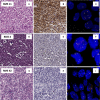Anaplastic lymphoma kinase aberrations correlate with metastatic features in pediatric rhabdomyosarcoma
- PMID: 27385213
- PMCID: PMC5312284
- DOI: 10.18632/oncotarget.10368
Anaplastic lymphoma kinase aberrations correlate with metastatic features in pediatric rhabdomyosarcoma
Abstract
Rhabdomyosarcoma (RMS) is the most frequent soft tissue tumor in childhood and arises from immature mesenchymal cells committed to skeletal muscle differentiation. Anaplastic Lymphoma Kinase (ALK) is a receptor tyrosine kinase aberrantly expressed in several cancers. Moreover, ALK full-length receptor protein has been observed in RMS, although its clinical and functional significance is yet controversial. The role of ALK and its clinical relevance were investigated in a selected cohort of 74 FFPE pediatric RMS and a panel of RMS cell lines, evaluating its gene and protein status, utilizing Fluorescent In Situ Hybridization (FISH), immunohistochemistry (IHC) and Western blot approaches. Moreover, to get insight into its possible therapeutic relevance, effects of ALK silencing on cell proliferation, invasion and apoptosis were studied in RMS cells. ALK IHC positivity was significantly correlated with gene copy number gain, the alveolar subtype, PAX3/7-FOXO1 rearrangements, the presence of metastasis at diagnosis and a worse overall outcome. Furthermore, EML4-ALK fusion gene associated with higher protein expression was identified in an embryonal RMS. ALK silencing in RH30 ALK positive cells strongly inhibited invasion capability. Overall, our data suggest a potential role of ALK in pediatric RMS.
Keywords: EML4-ALK; anaplastic lymphoma kinase; chromosomal rearrangement; metastasis; rhabdomyosarcoma.
Conflict of interest statement
We declare that there are no potential conflicts of interests in relation to the work described.
Figures




References
-
- Arndt CA, Stoner JA, Hawkins DS, Rodeberg DA, Hayes-Jordan AA, Paidas CN, Parham DM, Teot LA, Wharam MD, Breneman JC, Donaldson SS, Anderson JR, Meyer WH. Vincristine, actinomycin, and cyclophosphamide compared with vincristine, actinomycin, and cyclophosphamide alternating with vincristine, topotecan, and cyclophosphamide for intermediate-risk rhabdomyosarcoma: children's oncology group study D9803. J Clin Oncol. 2009;27:5182–5188. - PMC - PubMed
-
- Dantonello TM, Int-Veen C, Harms D, Leuschner I, Schmidt BF, Herbst M, Juergens H, Scheel-Walter HG, Bielack SS, Klingebiel T, Dickerhoff R, Kirsch S, Brecht I, et al. Cooperative trial CWS-91 for localized soft tissue sarcoma in children, adolescents, and young adults. J Clin Oncol. 2009;27:1446–1455. - PubMed
-
- Oberlin O, Rey A, Sanchez de TJ, Martelli H, Jenney ME, Scopinaro M, Bergeron C, Merks JH, Bouvet N, Ellershaw C, Kelsey A, Spooner D, Stevens MC. Randomized comparison of intensified six-drug versus standard three-drug chemotherapy for high-risk nonmetastatic rhabdomyosarcoma and other chemotherapy-sensitive childhood soft tissue sarcomas: long-term results from the International Society of Pediatric Oncology MMT95 study. J Clin Oncol. 2012;30:2457–2465. - PubMed
-
- Sultan I, Ferrari A. Selecting multimodal therapy for rhabdomyosarcoma. Expert Rev. Anticancer Ther. 2010;10:1285–1301. - PubMed
MeSH terms
Substances
Grants and funding
LinkOut - more resources
Full Text Sources
Other Literature Sources
Molecular Biology Databases
Research Materials
Miscellaneous

